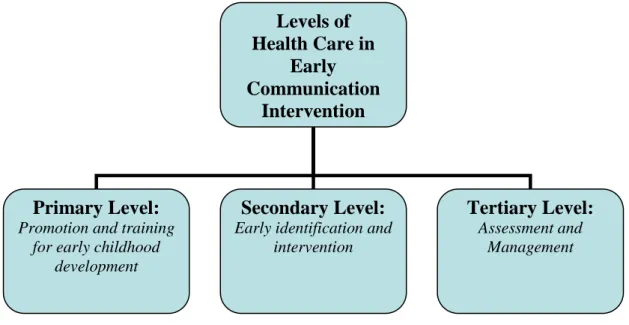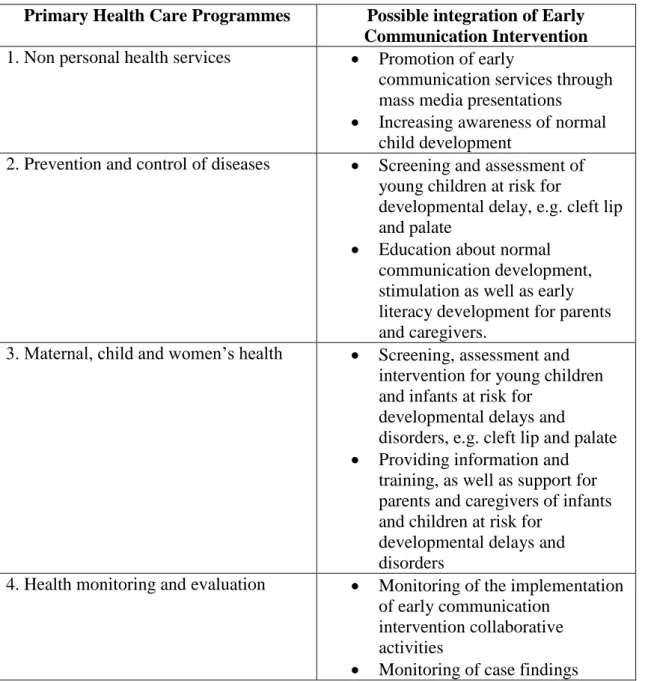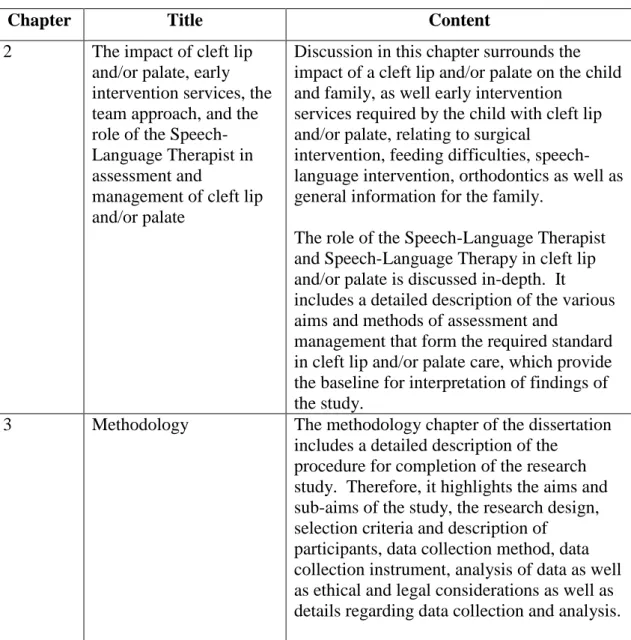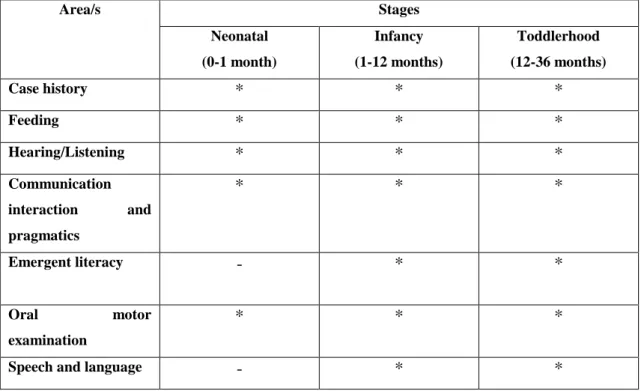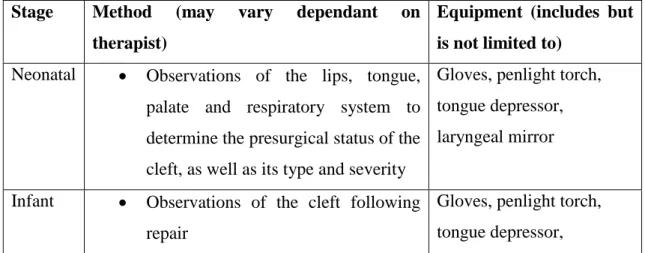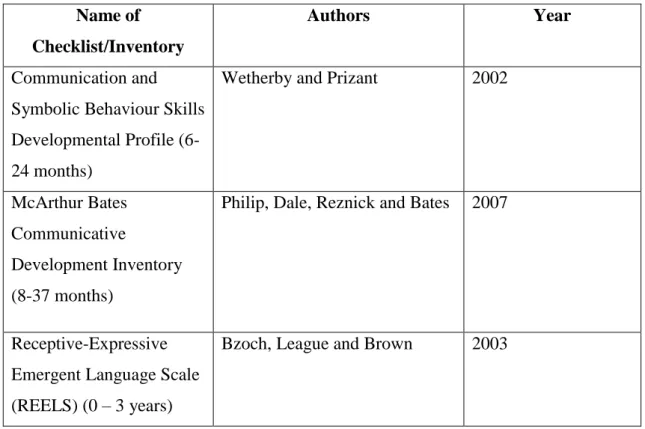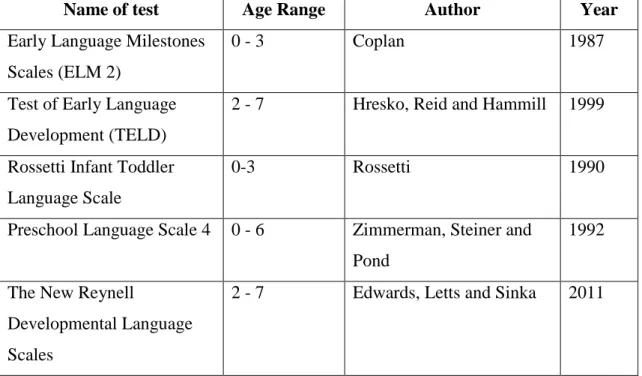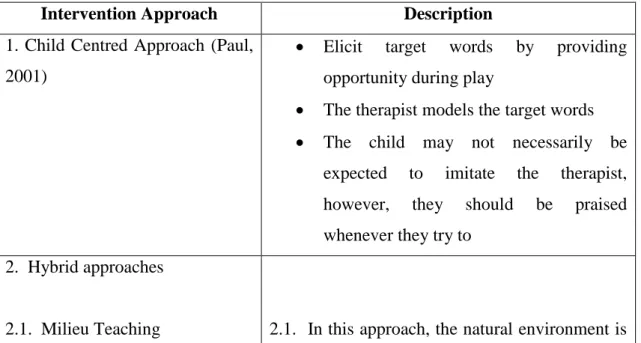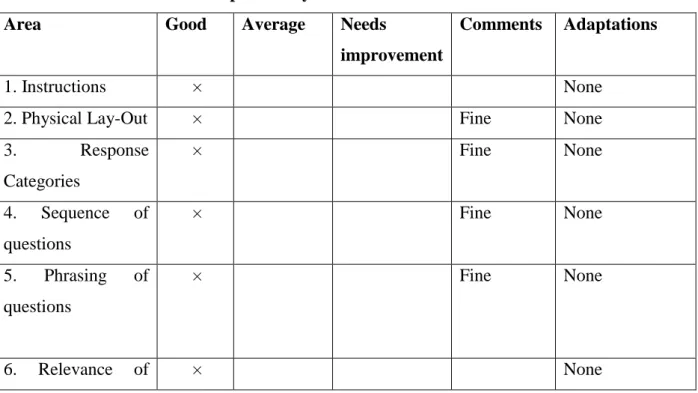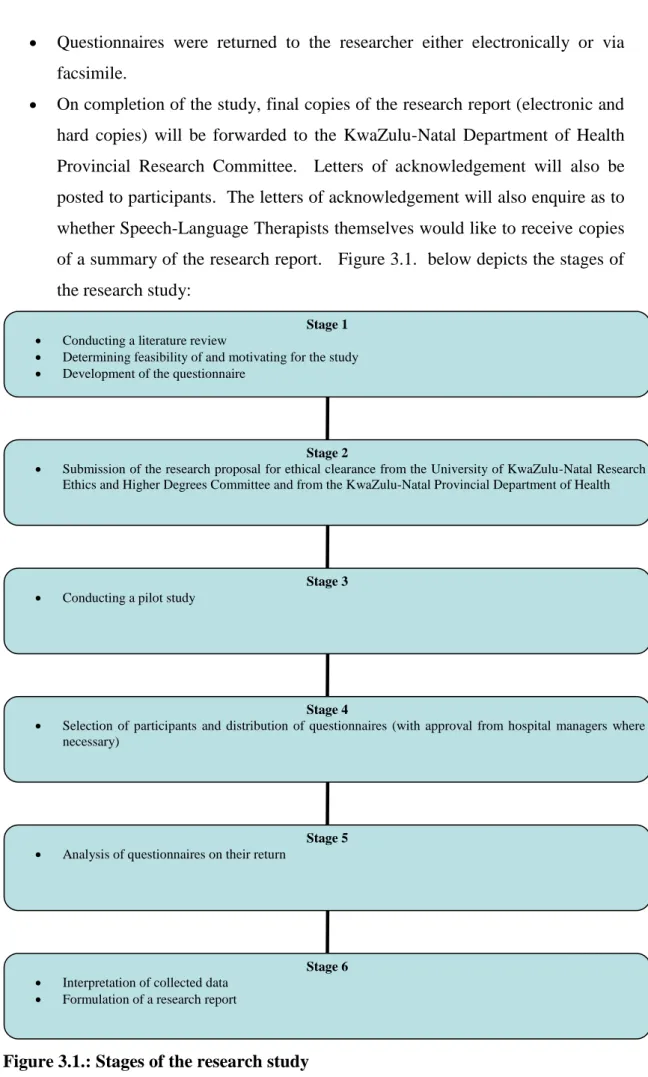AN OVERVIEW OF SPEECH-LANGUAGE THERAPY SERVICES FOR CHILDREN WITH CLEFT LIP AND/OR PALATE FROM BIRTH TO THREE YEARS WITHIN THE KWAZULU-NATAL HEALTH SECTOR
A Mini Dissertation presented to the Discipline of Speech-Language Pathology School of Audiology, Occupational Therapy and Speech-Language Pathology
Faculty of Health Sciences
University of KwaZulu-Natal (Westville Campus)
in partial fulfilment of the requirements for the degree
M. Communication Pathology (Speech-Language Pathology)
By:
Marlene Chetty
August 2011
DECLARATION
I, Marlene Chetty, declare that:
(i) The research reported in this dissertation, unless where otherwise indicated, is my original work.
(ii) This dissertation has not been submitted for any degree or examination at any other university.
(iii) This dissertation does not contain any other person’s data, pictures, graphs, or other information, unless specifically acknowledged as being sourced from other persons.
(iv) This dissertation does not contain any other person’s writing, unless specifically acknowledged as being sourced from other researchers. Where other sources have been quoted, then:
(a) their words have been rewritten but the general information attributed to them has been referenced.
(b) where their exact words have been used, their writing has been placed inside quotation marks, and referenced.
(v) This dissertation does not contain text, graphics or tables copied and pasted from the internet, unless specifically acknowledged, and the source being detailed in the dissertation and in the references section
Signed: ______________________________________________________________
Date: _________________________
ACKNOWLEDGEMENTS
God, who has guided me throughout my life and in all the decisions I have made, and allowing me to appreciate the privilege of completing a research study into a clinical area I love.
Chris and Theresa Chetty, for my life and accomplishments would never be without the strong, endless love and motivation from wonderful parents. Thank you for your encouragement to strive for academic success.
Saira Karrim and Jenny Pahl, for your supervision, guidance and encouragement throughout my master’s studies… your expertise in the field has taught me much!
Members of Staff at Grey’s Hospital and Phoenix Assessment and Therapy Centre, it has indeed been an honour to work with two wonderful, dedicated rehabilitation teams! Your input and suggestions were invaluable.
Tammy Rascher and Ms. Fikile Nkwanyana for your kind and valued assistance with statistical analysis.
The Speech-Language Therapists in KwaZulu-Natal, for this research study would not have been complete without your participation.
This dissertation is dedicated to:
My beautiful sister, Petrina Reddy… for being the inspiration behind my research in the field of cleft lip and/or palate
and
The children of South Africa…may this study pioneer further research and development in the levels of care for you all.
ABSTRACT
A descriptive survey with 19 Speech-Language Therapists from public health and four from private health was used to obtain an overview of Speech-Language Therapy services for children with cleft lip and/or palate from birth to three years in the KwaZulu-Natal Health Sector. Results are presented for public health, as none of the four private based respondents worked with cleft lip and/or palate from birth to three years. The number of Speech-Language Therapists (9) working with cleft lip and/or palate (0-3 years) in KwaZulu-Natal appears not to have changed significantly over the past two to three years, similar to the incidence of cleft lip and/or palate births.
Reasons for Speech-Language Therapists not working with this population included poor referrals and caseloads comprising of clients older than three years. A team approach to cleft care appears challenging but showing development. There are currently four institutions where professionals function as multidisciplinary teams, consisting mainly of Speech-Language Therapists, doctors and nurses. Speech- Language Therapists’ assessments include case history taking, oral peripheral examination, observational feeding assessment and speech-language assessment.
Most therapists are consulted within a few days of the birth, which is consistent with international guidelines. Audiological assessment and assessment of resonance were mentioned by a minority of participants. Feeding devices for cleft lip and/or palate are not always available immediately, and hence appears contradictory to the National Rehabilitation Policy. Recommendations include undertaking similar research in other provinces, so as to build a nationwide overview of services for South African children with cleft lip and/or palate.
CONTENTS
CHAPTER ONE
INTRODUCTION AND ORIENTATION TO THE FIELD OF CLEFT LIP AND/OR PALATE
_____________________________________________________________________
1.1. Introduction 18
1.2. Historical perspectives on cleft lip and/or
palate care 20
1.3. The South African health system 21
1.3.1. Charter of the public and private health sectors of the
Republic of South Africa 22
1.3.2. National rehabilitation policy 23
1.3.3. South African Speech-Language-Hearing Association guidelines for Speech-Language Therapists in early
communication intervention 24
1.4. Rationale for cleft lip and/or palate research in the developing world and
South Africa 28
1.5. Brief outline of chapters 30
1.6. Summary of chapter 31
CHAPTER TWO
THE IMPACT OF CLEFT LIP AND/OR PALATE, EARLY INTERVENTION SERVICES, THE TEAM APPROACH, AND THE ROLE OF THE SPEECH-
LANGUAGE THERAPIST
_____________________________________________________________________
2.1. Introduction 32
2.2. The impact of a cleft lip and/or palate 33 2.2.1. The impact of a cleft lip and/or palate on communication 33 2.2.2. The impact of a cleft lip and/or palate on feeding 37
2.3. Early intervention services required by
the child with cleft lip and/or palate 37
2.3.1. Early surgical intervention 37
2.3.2. Early feeding and swallowing intervention 39
2.3.3. Early dental/orthodontic intervention 42
2.3.4. Early audiological intervention 43
2.3.5. Early speech-language intervention 45
2.3.6. General information for the family 47
2.4. The role of teams in early intervention
for cleft lip and/or palate 49
2.5. The role of the Speech-Language Therapist in the assessment and management of cleft
lip and/or palate 51
2.5.1. Assessment 51
2.5.2. Therapy/management 60
2.6. Summary of Chapter 67
CHAPTER THREE
METHODOLOGY
_____________________________________________________________________
3.1. Aim 69
3.2. Objectives 69
3.3. Research design 70
3.4. Participant selection and description 72
3.4.1. Study population 72
3.4.2. Participant selection criteria 73
3.4.3. Sampling technique 73
3.4.4. Description of participants and sample size 74
3.5. Data collection instrument 74
3.6. Pilot study 78
3.7. Data collection process and method 79
3.8. Ethical and legal considerations 81
3.8.1. Ethical clearance 81
3.8.2. Informed consent 81
3.8.3. Confidentiality 81
3.8.4. Reliability and validity 82
3.9. Analysis of data 82
3.10. Summary of chapter 82
CHAPTER FOUR
RESULTS AND DISCUSSION
_____________________________________________________________________
4.1. Objective one:
Current levels of Speech-Language
Therapy services 84
4.2. Objective two:
Types and composition of team services 91 4.3. Objective three:
Levels of consultation with Speech-
Language Therapists 95
4.4. Objective four:
Existence and nature of policies for cleft lip
and/or palate 102
4.5. Objective five:
An overview of the aims and methods
of assessment 105
4.6. Objective six:
An overview of speech, language and
feeding management services 109
4.7. Objective seven:
Views of Speech-Language Therapists with regard
to services for cleft lip and/or palate 115
4.8. Summary of chapter 116
CHAPTER FIVE
CONCLUSION AND IMPLICATIONS
_____________________________________________________________________
5.1. Conclusion of the research study 118
5.2. Limitations of the research study 121
5.3. Implications of the research study 121
5.4. Recommendations for future research 122
5.5. Summary of chapter 123
LIST OF APPENDICES
Appendix A1:
Ethical Clearance Letter from the University of KwaZulu-Natal Ethics
Committee 139
Appendix A2:
Letter of Approval from the KwaZulu-Natal Provincial Department of
Health 140
Appendix B:
Letters of permission to heads of institutions 141
Appendix C:
Invitation to participate and informed consent for participants 143 Appendix D:
Questionnaire to Speech-Language Therapists employed in public health sector 148 Appendix E:
Questionnaire to Speech-Language Therapists employed in health in private
practice 155
Appendix F:
Public health institutions in KwaZulu-Natal 162
LIST OF TABLES AND FIGURES
LIST OF TABLES
Table 1.1. Primary Health Care Programmes in which Early Communication
Intervention may be Implemented 27
Table 1.2. Outline of the Chapters and Content of this dissertation 30
Table 2.1. Areas for assessment of communication and the stages at which each may be assessed 51
Table 2.2. Summary of Oral Motor Examination 54
Table 2.3. Checklists for language development 59 Table 2.4. Formal Assessments/Norm Referenced Tests of Language 59
Table 2.5. Approaches to increase early vocabulary 63
Table 3.1. Description and motivation for sections included in
questionnaire 75
Table 3.2. Results of the pilot study 78
Table 4.1. Ranking of referrals from other departments/professional persons 100
LIST OF FIGURES
Figure 1.1. Illustration of the levels of prevention within early
communication intervention 26
Figure 3.1. Stages of the research study 80
Figure 4.1. Number of public sector Speech-Language Therapists currently working with children with cleft lip and/or
palate from birth to three years of age 85
Figure 4.2. Number of Speech-Language Therapists based in the private health sector currently working with children with cleft lip and/or palate from birth to
three years of age 85
Figure 4.3. Number of public sector Speech-Language Therapists who have worked with children with cleft lip and/or palate from birth to three years of age within the past
two to three years 86
Figure 4.4. Number of Speech-Language Therapists based in
the private health sector who have worked with children with cleft lip and/or palate from birth to three years of
age within the past two to three years 87
Figure 4.5. Reasons why Speech-Language Therapists in the public health sector have not been working with
children with cleft lip and/or palate 88
Figure 4.6. Reasons why Speech-Language Therapists based in the private health sector have not been working
with children with cleft lip and/or palate 88
Figure 4.7. Speech-Language Therapists currently working within
cleft palate teams or in isolation 91
Figure 4.8. Types of existing teams for services for children
with cleft lip and/or palate 92
Figure 4.9. Total number of children with cleft lip and/or palate within the age range birth to three seen by
Speech-Language Therapists currently working in
the public health sector of KwaZulu-Natal 95
Figure 4.10. Correlation between total number of children with cleft lip and/or palate from birth to three seen by Speech-Language
Therapists and the number of children
with a cleft attending their hospital 96
Figure 4.11. Frequency of consultation with Speech-Language Therapists at the birth of a child with a cleft lip
and/or palate at institutions 98
Figure 4.12. Time of consultation with Speech-Language Therapists at the
birth of a child with a cleft lip and/or palate 99
Figure 4.13. Existence of institutional policies for cleft lip and/or palate 102
Figure 4.14. Existence of Speech-Language Therapy departmental policies
for cleft lip and/or palate 103
Figure 4.15. Participant’s responses to ‘Is a policy necessary?’ for services
to children with cleft lip and/or palate 104
Figure 4.16. Availability of Speech-Language Therapy assistive
feeding devices for cleft lip and/or palate 113
GLOSSARY OF TERMS
Assessment
Assessment is a process in which valid, reliable information is collected, and then integrated and interpreted, such that a decision may be made about something.
The term ‘assessment’ may be used synonymously with ‘evaluation’. In Speech- Language Pathology, the Speech-Language Therapist conducts an assessment so as to make a professional diagnosis and identify if treatment is warranted, the treatment plan and is the basis for measuring progress. Assessment also warrants referrals to other professionals where necessary. Ultimately, every clinical decision is derived from the process of assessment (Shipley & McAfee, 2008, p. 4).
Assistive Devices
This refers to user friendly devices, utilising appropriate technology, used for the purposes of correcting impairments and limiting the effects of an anomaly or disability (Department of Health, 2000a). With regard to cleft lip and/or palate, assistive devices include modified bottles and teats specific to the condition so as to assist in a more effective feeding process (Wolf and Glass, 1992).
Cleft lip and/or palate
A cleft lip or ‘harelip’ results from the failure of closure of the primary palate, whereas a cleft palate involves failure of closure of the secondary palate (Gorlin, 1993). A cleft may occur unilaterally or bilaterally, and may affect speech and/or feeding.
Craniofacial anomalies
A craniofacial anomaly refers to a breakdown or malformation of the face, oral cavity and velopharyngeal valve, of which one such craniofacial disorder is cleft lip and palate (Kummer, 2001).
Early Intervention
According to Shonkoff and Meisels (2000), this is intervention that occurs at an early stage in the child’s life, which will minimise the impact of a condition (cleft lip and/or palate) on a child’s life and prevent further progression. The American Speech- Language-Hearing Association (ASHA, 2008) defines Early Intervention as services that are provided to the birth to three year old population of infants, toddlers and their families.
Early Communication Intervention
Early Communication Intervention refers to a transdisciplinary field, involving the assessment and treatment of children below the age of three who present with or are at risk for a communication, speech, language or oral motor delay or disability as well as their families (ASHA, 2008 and South African Speech-Language-Hearing Association [SASLHA], 2010).
Formal Measures
Formal testing in Speech-Language Therapy usually follows a particular format and has a standardised procedure, with normative data for analysis in terms of standard scores and comparison to same age counterparts, in this case, zero to three years (Beech, Harding & Hilton-Jones, 1993). There is no single test or a set of tests that may be right for all clients. The selection of test material should involve familiarisation and thought in terms of clinical decision making, e.g. age range and languages of standardisation of the test (Shipley & McAfee, 2008).
Informal Measures
Informal measures in Speech-Language Therapy are more descriptive than formal measures. These are usually based in a naturalistic context or situation using observations and are not standardized nor refer to normative data (Beech, Harding &
Hilton-Jones, 1993). For example, in the assessment of language in the zero to three year old client, a representative language sample should be obtained in different
naturalistic contexts and be between 50-100 words in length (Shipley & McAfee, 2008).
Language
Language is a form of social tool, a dynamic process used to accomplish a person’s goal of communicating. Language involves the “form of language (phonology, morphology, syntax), the content of language (semantics) and/or the function of language in communication (pragmatics)” (Owens, 2004, p. 4).
Management
In Speech-Language Pathology, ‘treatment’, is a term defined as “the medical and educational connotations of treating and teaching persons with communicative disorders” (Hegde & Davis, 1995, p. 205), as well as their families. In cleft lip and/or palate, management areas include therapy for speech difficulties, language difficulties, velopharyngeal insufficiency and feeding difficulties. For the purposes of this study, the term ‘management’ for children with cleft lip and/or palate from birth to three years is used synonymously with ‘treatment’ and ‘intervention’.
Primary Health Care
Primary Health Care (PHC) is essential health care, based on practical, scientifically sound and socially acceptable methods and technology made universally accessible to individuals and families in the community through their full participation and at a cost that the community and country can afford to maintain at every stage of their development in the spirit of self-reliance and self determination (World Health Organisation [WHO], 1978). In 1994, with the establishment of a democratic government in South Africa, the country adopted Primary Health Care as the centrepiece of all its health policies (Schaay & Sanders, 2008).
Private Health Sector
This health sector is responsible for provision of health services to the full paying population, such as those on a medical aid scheme in South Africa (Department of Health, 2000b), or those paying directly to the private institution using private funds (Mclntyre, 2010). Currently only 15 percent of the South African population belong to medical aid schemes (Mclntyre, 2010).
Public Health Sector
The public health sector is the sector that provides health services to the majority of the South African population. The Department of Health is central to public health and is the main provider for medical services, mainly provided for by Primary Health Care clinics, district, provincial and tertiary hospitals (Department of Health, 2000b).
The public health budget flows via intermediaries in the public sector such as the local, national and provincial departments of health (Department of Health, 2000b).
Speech
Kummer (2001) describes speech as a coordination between a number of subsystems, including respiration, phonation, resonance and articulation. Respiration involves adequate inspiration and expiration for phonation, phonation refers to the sound that is produced by the vocal folds as they begin to vibrate, resonance refers to the quality of speech produced by the air travelling through the supraglottic tract (Kummer, 2001).
Articulation refers to the alterations in the sound produced by the articulators, i.e. the lips, tongue, teeth, palate and jaw, resulting in the production of vowels and consonants (Kummer, 2001).
Speech-Language Therapist
“A Speech-Language Therapist is a health care and educational professional who assists in the promotion of normal communication, assessment, diagnosis, treatment and management of developmental or acquired speech disorders … as well as developmental or acquired disorders of language and language processing, and
developmental or acquired disorders of feeding and swallowing in a variety of settings ranging from private practice, private hospitals, government hospitals, rural clinics, tertiary institutions, schools, preschools, industries, communities and home environments” (Health Profession Council of South Africa [HPCSA], 2005, p. 5).
A Speech-Language Therapist may hold a single degree in Speech-Language Pathology, or may have qualified with a dual degree, where he/she is referred to as a Speech-Language Therapist and Audiologist.
Speech Sounds
According to Cardiff (n.d), in English, there are approximately 24 consonants, all grouped into five types, namely plosives, nasals, fricatives, affricates and approximants, classified according to the place, manner of articulation and voicing.
Plosives, or stops, are generally produced with a complete constriction in the oral cavity. These are further divided according to the place of articulation, and there are six in total - /p, b, t , d, k, g/.
Nasals also have constriction, as with plosives, except that here air passes through the nose, as in /m; n; /. Fricatives do not have as much constriction in the oral cavity, but friction occurs at the point of contact. There are nine fricatives, including /f/ and /v/. An affricate is basically a plosive and fricative produced in quick sequence by a single articulator. There are only two affricates in the English language, namely /t/
and /d/. An approximant does not include any friction at all, e.g. /l/ (Cardiff, n.d).
The isiZulu language has a much larger phonetic inventory, consisting of 59 consonant sounds and a unique click structure that does not occur in English (Naidoo, 2003).
Velopharyngeal Closure
This refers to the closure of the nasal airway, by elevating the soft palate and contracting the posterior and lateral pharyngeal walls (Peterson-Falzone, Trost- Cardomone, Karnell and Hardin-Jones, 2006).
Mpho* is a three month old girl, who was born with a unilateral cleft of the lip and palate. Following her birth, surgeons were called in to evaluate the status of her cleft, after which she was booked in for surgical repair of her cleft lip at three months of age. Three months later, on admission to the hospital for her operation, she is spotted by the resident Speech-Language Therapist during ward rounds. The Speech- Language Therapist is concerned, as Mpho’s mum reports nasal regurgitation of her formula since birth as well as other feeding difficulties. Despite her concerns over feeding, she was only given a pamphlet on cleft lip and palate and on feeding by nursing staff. She was not referred to the Speech-Language Therapist, who is at the hospital on a daily basis.
Nikiel* (three months old) was born at a hospital near to that of Mpho, also with a unilateral cleft of the lip and palate. At this hospital, a cleft lip and palate team is in the foundation stages. In his case, the Speech-Language Therapist was called in by the medical doctor soon after his birth. His parents received counselling about feeding as well as about speech and language development and stimulation thereof.
His parents were offered a modified teat to assist with bottle feeds initially, until he was fitted with an orthodontic palatal prosthesis. Nikiel’s parents are grateful for the early efforts the professionals at the hospital made for his well being.
The contrast between the above two cases is clear. Where one parent and baby received Speech-Language Therapy support and guidance from the onset, the other knew nothing of Speech-Language Therapy services until her baby was seen by the Speech-Language Therapist in the ward.
Why is it that these differences and disparities exist? Both hospitals have a Speech- Language Therapist present on a daily basis, so ideally both children should have received similar counselling and support at similar times. These thoughts are what led the researcher to consider this research topic – an investigation into Speech-Language Therapy services for children from birth to three years of age within the KwaZulu- Natal health sector.
* Names have been changed.
CHAPTER 1
INTRODUCTION AND ORIENTATION TO THE FIELD OF CLEFT LIP AND/OR PALATE
The aim and focus of the chapter is to discuss cleft lip and/or palate, in relation to definitions of the condition, statistics relevant internationally and to South Africa, as well as a section surrounding the historical perspectives on cleft lip and/or palate treatment, both internationally as well as in South Africa. The chapter will also provide insight into international as well as national policies and protocols related to early intervention and cleft lip and/or palate within the South African health system.
In addition, this chapter will provide a rationale for research into the services provided for children with cleft lip and/or palate within the birth to three years age range.
1.1. INTRODUCTION
For the majority of parents in the world, the birth of a newborn baby is a time of joy and celebration, a time which usually follows a happy pregnancy as well as a safe labour and delivery process. Following the newborn’s entry into the world, the first two years of life involves rapid development in cognition, physical development as well as speech and language (Owens, 2001). However, not all children are born healthy and as a perfect picture (Shonkoff & Meisels, 2000), such as those born with craniofacial anomalies. Craniofacial anomalies are rated as the fourth most common birth anomaly, affecting one in seven hundred live births in the United States (American Cleft Palate Craniofacial Association [ACPA], 2007). Mars, Sell and Habel (2008) report that approximately eighty percent of children with cleft lip and/or palate are born in developing countries, such as South Africa. Of the existing craniofacial anomalies, cleft lip and/or palate is the most common (ACPA, 2007).
Furthermore, approximately half of these cleft lip and/or palate children have other associated malformations (Kummer, 2001) and clefting also occurs as a manifestation of many genetic syndromes (Kummer, 2001).
A cleft lip or ‘harelip’ occurs through the failure of closure of the primary palate, whereas a cleft palate involves failure of closure of the secondary palate (Gorlin, 1993). According to McWilliams, Morris and Shelton (1990), clefts may be either
unilateral, or bilateral and may occur singly or in combination with each other. The etiology of cleft lip and/or palate is not definite, but is linked to genetics as well as the interaction between genetics and the environment (Kummer, 2001). Cleft lip, with or without the presence of cleft palate, and cleft palate in isolation affect approximately one in six hundred babies worldwide (World Health Organisation [WHO], 2000).
Therefore, assuming that there are fifteen thousand children born per hour worldwide, a child with a cleft is born every two and a half minutes (World Health Organisation [WHO], 2000). In South Africa, thirty three registered cases of cleft lip with or without cleft palate or isolated cleft palate were reported from 2001 to 2003 (WHO, 2007). The incidence of cleft lip, cleft palate or cleft lip and palate per one hundred thousand births in KwaZulu-Natal was estimated at 25.2 in 2005, 22.4 in 2007, and 30.0 in 2008 (Wilson, L., personal communication, August 14, 20091). These figures appear low at first glance, however in relation to other congenital anomalies such as albinism, anencephaly and clubfoot, cleft lip and/or palate ranks as the third most frequent congenital anomaly in KwaZulu-Natal (Wilson, L., personal communication, August 14, 2009).
The impact of a cleft lip and/or palate affects not only the child, but also the parents.
Services for cleft lip and/or palate are required prenatally (if the cleft was detected in utero), through birth, infancy and continuing into adulthood. These services may include, but are not limited to: surgical intervention, feeding intervention, dental and orthodontic management, speech-language assessment and therapy, audiological monitoring, as well as information provision (specific to the condition and age range) for parents. According to Hodgkinson et al. (2005), the pregnancy and birth stages are the earliest stages of intervention, which include working with parents and family as the key facilitators in the intervention process. The next stage of intervention involves the child functioning within the family system as well as external systems, e.g. school. As the child grows, a sense of individuality develops, acknowledging the need for possible psychological intervention during the teenage years, and lastly,
1 Lin Wilson is the contact person for the KwaZulu-Natal maternal, child and women’s health
department, which offers services to promote healthy lifestyles to reduce morbidity and mortality rate, especially in women and children. Due to a lack of published statistical data, it should be noted that these figures are only estimates of those cases which were reported during 2005-2008.
where necessary, further surgical or speech and language related intervention during the stages of adulthood (Hodgkinson et al., 2005).
1.2. HISTORICAL PERSPECTIVES ON CLEFT LIP AND/OR PALATE CARE
A historical perspective on cleft lip and/or palate care dates back as early as the Middle Ages. The first record of surgical repair of a cleft lip dates back to 390 AD, by a Chinese surgeon. In the sixteenth century, Pierre Franco published the first work on surgical repair of cleft lip (Franco, 1561, as cited in Shons, 1993). This was followed by centuries of development in the field, ultimately leading to the technology and experience of professionals in the field today.
In South Africa, the earliest reports of cleft lip and/or palate treatment date back to 1953, with the review of five hundred cases by Penn, Clayden and Bentel (1953).
According to Penn, Clayden and Bentel (1953), South African surgeons of the time were ‘ignorant’ of the nature of the condition, and hence experienced difficulties in approaching the condition in the appropriate manner. Furthermore, the study revealed that a lack of coordination existed with regard to treatments between surgeons, dentists and Speech–Language Therapists (then logopaeditians), as treatment was not a cooperative effort. Of five hundred cases of cleft lip and/or palate repair, two hundred and thirty individuals were having primary surgery for at least the second time. Many repairs had to be ‘redone’ due to the poor condition of the cleft, previously repaired by “incapable or untrained hands” (Penn, Clayden & Bentel, 1953, p. 484). The authors comment on the well being of the child being the ultimate goal of treatment, as well as constant follow up until the age of ten years. However, the high frequency of secondary deformities following surgical repair of the lip and/or palate indicated a general lack of even basic knowledge and skills of cleft lip and/or palate repair. The conclusion of the study was that, in the 1950’s, South Africa’s government was urged to take the necessary steps to ensure adequately trained surgeons within the major provincial hospitals in the country.
1.3. THE SOUTH AFRICAN HEALTH SYSTEM
Knowledge of health research policy and systems is crucial to achieve goals and understand the workings of a government system (Ranson and Bennett, 2009), as well as any health organisation. Furthermore, this knowledge assists in attaining global research priorities.
According to Strauss (1999), behind every society’s methods of resource allocation lie policies, values and justice, including those resources for craniofacial care. He further states that no condition provokes a more sympathetic response from both the public as well as political forces than visible impairments, such as craniofacial conditions.
Furthermore, Mars, Sell and Habel (2008) report that approximately eighty percent of children with cleft lip and/or palate are born in developing countries. It is therefore important that knowledge of South African systems and policies form the backdrop to this craniofacial centred study.
In 1994, with the establishment of a democratic government in South Africa, the country adopted Primary Health Care as the centrepiece of all its health policies (Schaay & Sanders, 2008). According to the World Health Organisation (1978), Primary Health care is defined as:
“Essential health care based on practical, scientifically sound and socially acceptable methods and technology made universally accessible to individuals and families in the community through their full participation and at a cost that the community and country can afford to maintain at every stage of their development in the spirit of self-reliance and self determination” (World Health Organisation, 1978).
Primary Health Care is thus important to the field of craniofacial disorders as well as other physical disorders in general, due to the need for universal accessibility. In addition, the majority of South Africa’s population live in poverty (Department of Health, 1997) and hence would require essential health care that is cost effective during the different stages of care. This is further discussed by Van Rensburg (2004), who states that South Africa’s Primary Health Care package is based on five
components of the Primary Health Care Model. These include that health care needs of every person should be addressed according to how people wish to receive care, that comprehensive health care should be available in rural areas, which in turn will improve service delivery, and that the focus should be on improving the quality of care to improve health in local communities, rather than mere administration of the health service.
The National Health Bill of 1994 sought to establish Primary Health Care in South Africa through the restructuring of the public health care system, i.e. integrating all health services under a single health ministry, establishing a well coordinated district health system and making comprehensive, community-based health care accessible to all South Africans by establishing PHC centres (Kautzky & Tollman, 2008). In addition, President Nelson Mandela, in 1994, announced the introduction of free health care for pregnant and lactating women, as well as children under the age of six (Mhlanga, 2008). Through the principal health status for maternal and child health in South Africa, this contributes to development of all young children, especially those at risk, as well as those mothers and children who live in poverty with their only access to health care being the nearby clinic (Kritzinger, 2000).
Following 1994, the development of South Africa’s health system involved the establishment of a number of charters and policies. Of particular interest to services for children with cleft lip and/or palate, are the Charter of the Public and Private Health Sectors of the Republic of South Africa (Department of Health, 2005), the National Rehabilitation Policy (Department of Health, 2000a) and South African Speech-Language-Hearing Association (SASLHA) Guidelines for Speech–Language Therapists in early intervention (Louw, 1997).
1.3.1. Charter of the Public and Private Health Sectors of the Republic of South Africa (2005)
According to Kautzky and Tollman (2008), an obstacle to development and the adequate provision of health services exists as a consequence of the apartheid system of separate health services, the establishment of the private sector, as well as the unequal distribution of health resources and personnel between the private and public
health sectors. The aim of this charter (Department of Health, 2005) was for the parties involved to create a South African health system that is efficient and coherent, as well as cost effective for the entire population, including for cleft lip and/or palate individuals and families. This can be achieved through the optimal utilisation of both public and private health services to benefit the entire country’s population. It was agreed upon for the public and private health sectors to establish mutual cooperation, trust and respect, which will in turn improve health care at all levels. However, there are a number of challenges which the South African health system faces, in particular with regard to access to services, financing, equity, and human resources. A strong argument exists that the key challenge facing the health system is not inadequate resources, but rather the inequitable and inefficient application of these resources.
According to Kautzky and Tollman (2008), in 1998 the majority of general practitioners, health nurses and specialists worked in the private health sector, despite the fact that this sector caters for only twenty percent of the population. In 2005, the Department of Health reported that the situation still existed, and that suitably qualified and trained health care personnel are still not equally distributed throughout the national health care system (Department of Health, 2005). Furthermore, the private sector utilises approximately sixty two percent of the national health expenditure to provide for only seven million people, whereas the public health sector utilises only thirty eight percent to provide for approximately thirty five million residents (Kautzky & Tollman, 2008). This is further aggravated by the lack of affordability of belonging to a medical aid scheme, which results in an increasing number of South Africans relying on public health care.
1.3.2. National Rehabilitation Policy (Department of Health, 2000a)
This policy focuses on the standardisation of provision of assistive devices in South Africa, designed for application in the public health sector. Of particular interest to the field of Speech-Language Therapy and Audiology is the provision of assistive devices for communicatively impaired individuals (speech, voice, language disorders, feeding, hearing disorders and deafness) (Department of Health, 2000a). With regard to cleft palate, assistive feeding devices may include specialized feeding bottles or nursers (Wolf & Glass, 1992), which would have to be ordered where necessary. The
policy promotes the development of a budget at provincial and regional or district level for the provision of assistive devices, and states that the assessment and prescription for an assistive device should only be made by the relevant, appropriately trained rehabilitation provider. Thus, in the case of Speech–Language Pathology, the Speech–Language Therapist is the professional who selects, prescribes, issues and trains the individual and their family in the use of the assistive device. In the case of a specialised feeding bottle, the mother would require training. Prescription forms do not have to be signed by a medical practitioner or superintendent, but should be co- signed by individual department heads (Department of Health, 2000a). Furthermore, instant access to assistive devices for infants, children and adults with feeding and swallowing difficulties, e.g. cleft palate, stroke and cerebral palsy, should be guaranteed (Department of Health, 2000a). At the latest, it should be provided on discharge. This is due to the fact that, unlike typically developing infants/neonates, parents of babies with cleft lip and/or palate are required to assist in establishing the suck-swallow breathe feeding pattern for the neonate, via the use of the specialized bottles.
1.3.3. SASLHA guidelines for Speech–Language Therapists in Early Communication Intervention
As this study focuses on the birth to three year age range, it is necessary to explore the field of early intervention and early communication intervention in South Africa, as it is this area into which children with cleft lip and/or palate fit.
According to Shonkoff and Meisels (2000), the term early intervention refers to intervention that occurs at an early stage in the child’s life, which will minimise the impact of a condition on a child’s life and prevent further progression. There has been much speculation regarding the age range for early intervention services, however in South Africa, it has been established that the first three years of a child’s life is considered the ‘critical’ developmental period, and hence the period in which early intervention services are provided (Billeaud, 2003).
Early communication intervention refers to a transdisciplinary field, involving the assessment and treatment of children below the age of three who present with or are at
risk for a communication, speech, language or oral motor delay or disability as well as their families (American Speech-Language-Hearing Association [ASHA], 2008 &
SASLHA, 2010). According to Rossetti (2001), delayed communication development is one of the most common symptoms of developmental delays and disorders.
Communicative ability correlates highly with later intelligence and performance at school (Rossetti, 2001). Rossetti (2001) states that early communication intervention services have high probability to make long term, positive differences for children with developmental delays and disorders. Furthermore, as cleft lip and palate is defined as an established risk factor for communication difficulties, i.e. a factor that has the potential to have adverse effects on developmental outcomes (ASHA, 2008), it is clear that early communication intervention (as well as surgical intervention in this case) for this population and their families is vital.
According to Louw (1997), early communication intervention can be implemented as a preventative strategy at primary, secondary and tertiary levels of health care, with the aim of reducing the occurrence as well as severity of conditions (such as cleft lip and/or palate) which have potential to impede communicative development. At the primary prevention level of health care, promotion and training for early childhood development should occur. At the secondary prevention level, early identification and intervention occurs. At the tertiary level of prevention, intervention, which includes assessment and management, occurs (Louw, 1997). The levels are demonstrated below:
Figure 1.1. Illustration of the levels of prevention within early communication intervention
In accordance with the announcement of free health services to children under the age of six, SASLHA propagated a nationwide movement toward implementing early communication intervention for disorders, including cleft lip and/or palate in South Africa. These guidelines for intervention stress the following points:
Developmental gains are greater if intervention begins earlier,
Intervention should be sensitive to the family’s geographical and cultural settings,
Intervention should be family centred, involving the family directly, and within their daily activity, either based at an institution or at home,
Intervention can be indirect (e.g. to nursing staff in the neonatal intensive care unit) or direct (to the family),
Teamwork and the transdisciplinary team is strongly advocated, together with counselling, training and information for caregivers,
Services should be family centred, including culturally and linguistically acceptable, and
Levels of Health Care in
Early Communication
Intervention
Primary Level:
Promotion and training for early childhood
development
Secondary Level:
Early identification and intervention
Tertiary Level:
Assessment and Management
Services should ultimately promote a child’s participation in their natural environment, services should be part of a coordinated team basis, and be evidence-based (Louw, 1997 & ASHA, 2008)
In addition to the above, Van de Linde (2008, p. 48) discusses the various Primary Health Care programmes in which early communication intervention may be implemented. Those related to cleft lip and/or palate are described in Table 1.1.
below.
Table 1.1.: Primary Health Care Programmes in which early communication intervention may be implemented
Primary Health Care Programmes Possible integration of Early Communication Intervention 1. Non personal health services Promotion of early
communication services through mass media presentations
Increasing awareness of normal child development
2. Prevention and control of diseases Screening and assessment of young children at risk for
developmental delay, e.g. cleft lip and palate
Education about normal communication development, stimulation as well as early literacy development for parents and caregivers.
3. Maternal, child and women’s health Screening, assessment and intervention for young children and infants at risk for
developmental delays and
disorders, e.g. cleft lip and palate
Providing information and training, as well as support for parents and caregivers of infants and children at risk for
developmental delays and disorders
4. Health monitoring and evaluation Monitoring of the implementation of early communication
intervention collaborative activities
Monitoring of case findings
1.4. RATIONALE FOR CLEFT LIP AND/OR PALATE RESEARCH IN THE DEVELOPING WORLD AND SOUTH AFRICA
Craniofacial anomalies, such as cleft lip and/or palate incur considerable costs related to morbidity and health care, social and employment issues, as well as personal issues in families and society (World Health Organisation [WHO], 2000). In the developed world, there have been great advances in medical care. In developing countries such as South Africa, challenges exist mainly due to issues such as limited resources.
According to Mars, Sell and Habel (2008), approximately eighty percent of children with cleft lip and/or palate are born in the developing world, where cleft care services may not always be adequate. With regard to Speech-Language Pathology, Speech- Language Therapists in the developing world are required to take responsibility for highlighting their own role on the early intervention team for children with cleft lip and/or palate (Eurocran Speech Project, 2000). This is due to the limitations in availability of these professionals as well as services being only recently introduced in some countries. A clear example of this, according to Van de Linde (2008), was that in 2005, only one Speech-Language Therapist and Audiologist serviced the entire Ditsobotla sub-district in the North West Province of South Africa, hence little attention was paid to early communication intervention due to the increased workload.
This could have resulted in ‘missing out’ on those children at risk for communication delays.
The majority of South Africa’s population live in poverty, where early intervention services, especially those required for communication, are scarce (Fair & Louw, 1999, as cited in Kritzinger, 2000). Three problems relating to the provision of early intervention services in South Africa are highlighted below:
In South Africa, there exists an increased number of children with or at risk for communication delays and disorders, hence indicating the need for proper early communication intervention services (Kritzinger, 2000).
As the majority of South Africans reside in rural and poverty-stricken areas where there are fewer health facilities and fewer early intervention facilities
(Kautzky & Tollman, 2008), identification of children for such services is difficult and complicated.
The above mentioned scarcity of early intervention facilities may lead to health care workers in the existing facilities having poor knowledge of the importance of referrals to Speech-Language Therapists in the case of cleft lip and/or palate, which further undermines the importance of developing early communication intervention in South Africa.
The health of children is therefore largely dependent on the services available and offered to them, and the clinical expertise of the professionals who serve them.
Despite much improvement in the services and level of care for children, many children may still receive care that is “substantially inferior to what can or could be provided” (ACPA, 2000, p. 1). In South Africa, an assessment of the healthcare system by the South African Human Rights Commission in 2007 recorded great concern about the levels of access to healthcare services and the quality of care provided in the public healthcare system, despite existing policy and legislation governing this sector (Netcare, 2008). With specific reference to cleft lip and palate, care for these children is challenged in South Africa, as children with clefts present a minority in terms of requirements for health services, compared to other conditions such as HIV/AIDS. Due to these reasons, this research study may advocate for collaboration between parents, patients and healthcare organisations to motivate for the necessary resources for holistic care of the child with cleft lip and/or palate, which may in turn educate political leaders, such as health ministers, to seek stricter legislation for access to quality care (Strauss, 1999). In addition, the future of cleft teams in KwaZulu-Natal and South Africa may be more clearly defined, and the vital role of the Speech-Language Therapist will receive more justification in addition to surgical requirements being a priority.
Investigations into the areas and methods of assessment and management used by Speech-Language Therapists for children with cleft lip and/or palate may be of particular help to those therapists who see only a few children with cleft lip and/or palate, as it will provide information on candidacy for treatment, and, more importantly, the most common methods used which aims to increase confidence for
working with this client group, as this helps to bridge the gap between theory and practice.
While services for cleft lip and/or palate begin at birth and continue to adulthood, the aim of this research study is to investigate the early Speech-Language Therapy services for children with cleft lip and/or palate in the province of KwaZulu Natal.
1.5. BRIEF OUTLINE OF CHAPTERS
An outline of the chapters of this research study is presented in Table 1.2. below.
Table 1.2. An outline of the chapters and content of this dissertation
Chapter Title Content
2 The impact of cleft lip and/or palate, early intervention services, the team approach, and the role of the Speech- Language Therapist in assessment and
management of cleft lip and/or palate
Discussion in this chapter surrounds the impact of a cleft lip and/or palate on the child and family, as well early intervention
services required by the child with cleft lip and/or palate, relating to surgical
intervention, feeding difficulties, speech- language intervention, orthodontics as well as general information for the family.
The role of the Speech-Language Therapist and Speech-Language Therapy in cleft lip and/or palate is discussed in-depth. It includes a detailed description of the various aims and methods of assessment and
management that form the required standard in cleft lip and/or palate care, which provide the baseline for interpretation of findings of the study.
3 Methodology The methodology chapter of the dissertation includes a detailed description of the
procedure for completion of the research study. Therefore, it highlights the aims and sub-aims of the study, the research design, selection criteria and description of
participants, data collection method, data collection instrument, analysis of data as well as ethical and legal considerations as well as details regarding data collection and analysis.
4 Results and Discussion This chapter focuses on the findings of the study, deduced by the results of analysis.
Results are described quantitatively for the closed ended questions, and qualitatively (discussion surrounding the emergent themes) for open ended questions. The results are then interpreted in light of current and previous literature and previous research.
5 Conclusion and
Implications
This chapter provides a detailed description of the conclusions deduced from the research study, together with theoretical implications of the study, as well as implications for clinical practice. Recommendations for further research are also outlined. The limitations of the study are presented.
1.6. SUMMARY OF CHAPTER
Chapter One provided an overview of the background and rationale to this research study, with specific reference to international and national literature, policies and guidelines. The chapter began with aspects relating to definitions and statistical information for cleft lip and/or palate internationally and in South Africa, and furthermore described the historical perspectives on cleft lip and/or palate care. Cleft lip and/or palate care has shown significant improvements since the 1950’s, the decade which it dates back to in South Africa. The South African health care system has also undergone significant change since the introduction of Primary Health Care in 1994, which was also discussed in the chapter. In addition, a description of the South African health system as related to cleft lip and/or palate care, as well as early communication intervention was described.
CHAPTER 2
CLEFT LIP AND/OR PALATE: IMPACT, EARLY INTERVENTION SERVICES, THE TEAM APPROACH, AND THE ROLE OF THE SPEECH-
LANGUAGE THERAPIST
This chapter will provide insight into the impact of a cleft lip and/or palate on the child as well as the family. Discussion in this chapter will focus on the early intervention services required by the child with cleft lip and/or palate, relating to surgical intervention, feeding difficulties, orthodontic management (as these are primary concerns) as well as general information for the family, with an emphasis on speech-language service provision.
The role of the Speech-Language Therapist and Speech-Language Therapy in cleft lip and/or palate will be discussed in depth. It will include a detailed description of the various aims and methods of assessment and management comprising the required standard in cleft lip and/or palate care, which will provide the baseline for interpretation of findings of the research study. This chapter also contains ‘anecdotal’
evidence from various local professionals in the field of cleft lip and/or palate (this information was gathered for a previous assignment in the field, and did not form part of date collection) in order to enhance information from the limited amount of literature reviews available.
2.1. INTRODUCTION
Infants and toddlers born with cleft lip and/or palate are at a higher risk for the development of difficulties with feeding, hearing, and communication, as well as possible problems in the caregiver-child relationship (Peterson-Falzone, Trost- Cardomone, Karnell and Hardin-Jones, 2006). Due to the diverse effects of the condition, parameters for ‘best practice’ have been developed by international organisations such as the American Cleft Palate-Craniofacial Association [ACPA]
(2000). In addition, it is a standard guideline that the earlier the care for the child with a cleft lip and/or palate, the better the outcome (Kummer, 2001).
2.2. THE IMPACT OF A CLEFT LIP AND/OR PALATE
2.2.1. The impact of cleft lip and/or palate on communication
Communication is vital in a child’s development. In children with cleft lip and/or palate, however, there is a higher risk for communication difficulties when compared to typically developing children, and the impact thereof may be seen in the following areas of communication: prelinguistic behaviour, speech (articulation), voice, resonance, language and hearing (Kummer, 2001). These are discussed in detail below.
Impact of a cleft lip and/or palate on vocalisations and early prelinguistic behaviours
As a young child develops, they move toward the production of speech and speech sounds by developing their oral motor control, by vocalising, sensory integration, social interaction, mother-child interaction, as well as interaction with the environment (Owens, 2001). However, in children with cleft lip and palate, there exists a deviance in prelinguistic development.
The impact of the cleft may include delay in the emergence, variations and developing complexity of babbling, reduction in the use of consonants (particularly labial and lingual sounds), with more frequent use of nasal consonants and glottal stops, as well as alterations in mother child interaction, possibly due to psychosocial aspects related to the mother’s acceptance of the structural malformation (Albery and Russell, 1994).
Furthermore, it is not always possible to determine at this prelinguistic stage whether the lack of plosives is due to velopharyngeal insufficiency or other factors, such as hearing difficulties or a delay in speech sound (plosives) acquisition. However, this is a good indicator for those at risk for deviant and delayed phonological characteristics (Albery & Russell, 1994).
Impact of a cleft lip and/or palate on speech
According to Albery and Russell (1994), following surgery, by eighteen months of age, children with clefts of the lip and/or palate demonstrate development with regard to the production of labial plosives as well as fricatives. Despite this there may still be deviant phonetic behaviours in their early speech patterns. Russell (1993, as cited in Albery and Russell, 1994) reports a close relationship between phonetic and phonological development in children with cleft lip and/or palate, as a delay in phonetic development may cause a delay in phonological development.
According to Trost-Cardomone (2008), cleft palate speech is frequently characterised by maladaptive compensatory articulations. These compensatory articulations may occur as substitutions, where target sounds are replaced as co-productions (a ‘double articulation), as retracted or ‘backed’ productions (e.g. alveolars produced as palatals or velars, or palatal productions produced in the velar or uvular place). These in turn may have a negative impact on the intelligibility of speech.
Thus, the speech errors of the child with cleft lip and/or palate may be placed into two broad categories, namely the obligatory problems (these have a physical basis which Speech-Language Therapists are unable to treat, e.g. obligatory nasal emission due to a fistula) and the learned problems (such as maladaptive compensatory articulations) which form part of the Speech-Language Therapists’ treatment (Trost-Cardomone, 2008).
Impact of a cleft lip and/or palate on voice and resonance
According to Stengelhofen (1990), there exists high evidence of vocal fold pathologies in children with cleft palate, and hence the phonatory characteristics of a child (pitch, loudness and quality) may be affected. Furthermore, disorders of resonance are the major area of concern in children with cleft palate (McWilliams, Morris & Shelton, 1990).
Hypernasality, nasal air emission as well as the presence of facial grimacing are more often than not the resultant impact of velopharyngeal dysfunction or insufficiency (McWilliams, Morris & Shelton, 1990). Hyponasality may be caused by an obstruction in the nasopharynx, or as a result of maxillary retrusion as seen in many syndromic cases (Gopal, 2009). According to Kummer (2001) even children with cleft lip and/or palate who have undergone surgical repair of the cleft may still present with velopharyngeal insufficiency, post operative fistulas as well as incorrect, learned speech patterns.
According to Trost-Cardomone (2008) abnormal velopharyngeal closure leads to abnormal speech patterns, by affecting speech resonance and speech airflow.
Excessive nasal resonance is particularly seen on vowels and sonorant consonants (glides and liquids). The presence of excess nasal emission and airflow in place of oral emission and airflow results in weaker oral pressure for those consonants requiring high pressure, such as fricatives, stops and affricates (Trost-Cardomone, 2008). Audible nasal air emission on high pressure targets may occur as substitutions or co-productions (distortions) (Trost-Cardomone, 2008).
Impact of a cleft lip and/or palate on language development
Rossetti (2001) reports that the development of language may be influenced by social interaction, biological capability, cognitive capability and hearing ability. Therefore anomalies, i.e. established risk factors such as cleft lip and/or palate, have a broad effect on the development of language due to the impact of the cleft on development.
Furthermore, in developing countries, aspects such as socioeconomic deprivation may play a role in language delays and disorders (Gopal, 2009).
McWilliams, Morris and Shelton (1990) report that even the earliest studies of development of communication in children with cleft lip and/or palate focused on articulation ability and the vocabulary repertoire, with little focus on other aspects of language use. One of the earliest studies of language development was conducted by Sprietersbach et al. (1958, as cited in McWilliams, Morris & Shelton, 1990). This study concluded that children with clefts had a shorter mean length of utterance as compared to typically developing children, however no difference was found in terms
of structural complexity, i.e. syntax and morphology. These children were limited in their use of vocabulary (semantics), however not limited in their recognition of vocabulary.
Many studies originating from that of Sprietersbach et al. (1958, as cited in McWilliams, Morris & Shelton, 1990) found that children with clefts scored lower than their non cleft counterparts in language development tests. However, Horn (1972, as cited in McWilliams, Morris & Shelton, 1990) acknowledged the possible contribution of hearing problems, poor caregiver-child interaction, ‘overprotective parents’ as well as the inferior modelling of speech to the reported language delays or deviances. McWilliams, Morris and Shelton (1990) stress that as Speech-Language Therapists, it is of utmost importance to remember the possibility of language delays and understand the need for cautious evaluation of language.
Impact of a cleft lip and/or palate on hearing
Dysfunction of the Eustachian tube is a common cause of middle ear disease in children with cleft palate (Stool, 2006). The presence of a cleft palate affects the functions of the Eustachian tube, of which ventilation of the middle ear is most important. This dysfunction may arise as a result of the Eustachian tube being obstructed, or by infection caused through reflux (due to the cleft) from the nasopharynx into the middle ear. Therefore, in the child born with a cleft palate, who may in all probability have some difficulty with speech production, the long term effects of otitis media are far more serious (Stool, 2006). The presence of Eustachian tube dysfunction leads to fluctuating conductive hearing loss, which, in addition to the structural defect, compounds speech and language difficulties (Royal College of Speech and Language Therapists, [RCSLT], 2005). This is due to the importance of consistent auditory input for language development. However, in a child with fluctuating hearing loss, they are likely to be missing out on frequent episodes of language input (McWilliams, Morris & Shelton, 1990).
2.2.2. The impact of a cleft lip and/or palate on feeding
Early feeding difficulties are a frequent occurrence in children with cleft palate, due to the absence of separation between the oral and nasal cavities. In addition, a cleft palate affects the child’s ability to create adequate intra-oral pressure to create a suck that expresses milk from the breast or bottle (Peterson-Falzone et al., 2006). Wolf and Glass (1992) also report the possibility of dental and orthodontic difficulties which may affect feeding. In addition to difficulty sucking, problems with regard to poor intake of the feed, nasal regurgitation, choking, gagging, reflux into the middle ear as well as excessive air intake are reported (Wolf & Glass, 1992). This would require adaptations in the presentation of feeding, areas of caution such as proper positioning of the infant, as well as the possibility for using modified feeding teats or bottles, dependant on type (e.g. lip or palate) or combination of cleft (e.g. lip and palate) (Peterson-Falzone et al., 2006).
2.3. EARLY INTERVENTION SERVICES REQUIRED BY THE CHILD WITH CLEFT LIP AND/OR PALATE
Six areas of early intervention for children with cleft lip and/or palate will be discussed. These are early surgical intervention, early feeding intervention, early dental/orthodontic intervention, early audiological intervention, early speech-language intervention as well as general information for the family.
2.3.1. Early Surgical Intervention
Surgical intervention for the child with cleft lip and/or palate is vital within the first year of his/her life (Lazarus, 2009). However, the surgery required may be confounded by the physical growth and development of the oral structures. A parallel relationship exists between surgery and development, as the surgery may profoundly affect growth, and, similarly, growth may profoundly affect the seemingly ‘perfect’
surgical results (Shons, 1993). For this reason, cleft lip and/or palate requires essential, long term follow up until the age of twenty, where the final results of numerous surgical procedures can be appreciated (Shons, 1993). According to the ACPA (2000), the primary surgery required by the child with cleft lip and/or palate is
